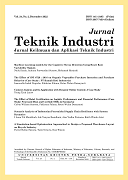Content Analysis and Its Application with Dynamic Online Content
A Case Study
DOI:
https://doi.org/10.9744/jti.24.2.105-116Keywords:
Content analysis , quantitative method , digital repositories , dynamic contentAbstract
Content analysis is a well-established and widely used research method. In its early form, it was used extensively in the quantitative analysis of newspapers, and its applications later evolved to include electronic media such as radio and television. It has recently been applied to digital media, including the Internet. However, the use of content analysis in analyzing online content has been chiefly applied to static content, such as ‘static’ websites, in the early days of the Internet. Studies that involve its use in analyzing dynamic Internet content—for example, content that resides behind databases—are relatively much less common. This article is not written as a research paper per se. This article will instead discuss reflections on the efficacy of content analysis as a research method when applied to dynamic content such as DRs by using a previous study, which has applied content analysis to the dynamic content of digital repositories (DRs), as a case study. The previous study used as the basis for this article had applied content analysis to several DRs using manual counting by the researcher. In the process, several idiosyncrasies in terms of the way institutions populate their DRs with digital objects and the user metadata to facilitate discoverability of those digital objects were encountered that have introduced some ‘complication.’ This article will focus on how content analysis, as a research method, can be adapted to account for those idiosyncrasies to produce better results. This article will also identify the limitations and challenges of content analysis in dynamic online environments and offer some suggested approaches.
Downloads
References
Krippendorff, K., Content Analysis: An Introduction to Its Methodology, 3rd ed., Sage Los Angeles, CA,, 2013.
Neuendorf, K. A., The Content Analysis Guidebook, Thousand Oaks, CA, 2002.
Rice, R. E. and Rogers, E. M., New Methods and Data for the Study of New Media. In R. E. Rice (Ed.), The New Media: Communication, Research, and Technology (pp. 81-99), Sage, Beverly Hills, CA, 1984.
Liauw, T.T., Institutional Repositories in the Indonesian Higher Education Sector: Current State and Future Prospect, Thesis, Faculty of Humanities, Curtin University, Western Australian, 2018,
https://espace.curtin.edu.au/handle/20.500.11937/73546.
Berelson, B., Content Analysis in Communication Research, Hafner Publishing Company, New York, NY, 1952.
Holsti, O. R., Content Analysis for the Social Sciences and Humanities, Addison-Wesley, Reading, MA, 1969.
Lasswell, H. D., Lerner, D. and Pool, I. d. S., The Comparative Study of Symbols, Stanford University Press, Standford, CA, 1952.
Lazarfeld, P. F. and Barton, A. H., Qualitative Measurement in the Social Sciences: Classification, Typologies, and Indices. In D. Lerner and H. D. Lasswell (Eds.), (Vol. The Policy Sciences: Recent Developments in Scope and Method, pp. 155-192), London, UK, 1951.
George, A., Quantitative and Qualitative Approaches to Content Analysis. In K. Krippendorff and M. A. Bock (Eds.), The Content Analysis Reader (pp. 144-155), Sage, Los Angeles, CA, 2009.
Mayring, P., Qualitative Content Analysis. Forum: Qualitative Social Research, 1(2), 2000.
Becker, J. and Lißmann, H.-J., Inhaltsanalyse - Kritik einer Sozialwissenschaftlichen Methode. Arbeitspapiere zur Politischen Soziologie 5, Olzog Verlag GmbH, Munich, 1973.
Ghose, S. and Dou, W., Interactive Functions and Their Impacts on the Appeal of Internet Presence Sites. Journal of Advertising Research, 38 (2), 1998, pp. 29–43.
Schneider, S. M. and Foot, K. A., The Web as an Object of Study, New Media & Society, 6(1), 2004, pp. 114-122, doi:10.1177/1461444804039912.
Herring, S. C., Web Content Analysis: Expanding the Paradigm. In J. Hunsinger, L. Klastrup, and M. Allen (Eds.), The International Handbook of Internet Research (pp. 233-249), Springer Verlag, 2013.
Newhagen, J. E. and Rafaeli, S., Why Communication Researchers Should Study the Internet: A Dialogue. Journal of Computer-Mediated Communication, 1(4), 1996, pp. 0-0,
doi:10.1111/j.1083-6101.1996.tb00172.x.
Weare, C. and Lin, W.-Y., Content Analysis of the World Wide Web: Opportunities and Challenges, Social Science Computer Review, 18(3), 2000, pp. 272-292, doi:10.1177/089443930001800304.
Bates, M. J. and Lu, S., An Exploratory Profile of Personal Home Pages: Content, Design, Metaphors. Online & CD Rom Review, 21(6), 1997, pp. 331-340.
McMillan, S. J., The Microscope and the Moving Target: The Challenge of Applying Content Analysis to the World Wide Web. Journalism and Mass Communication Quarterly, 77(1), 2000, pp. 80-98, doi:10.1177/107769900007700107.
Ha, L. and James, E. L., Interactivity Reexamined: A Baseline Analysis of Early Business Web Sites. Journal of Broadcasting & Electronic Media, 42(4), 1998, pp. 457-474,
doi:10.1080/08838159809364462.
Liauw, T. T. and Genoni, P., A Different Shade of Green: A Survey of Indonesian Higher Education Institutional Repositories, Journal of Librarianship and Scholarly Communication, 2017, doi:10.7710/2162-3309.2136.
Liauw, T. T., Longitudinal Content Analysis of Indonesian Higher Education Institutional
Repositories (Nov 19, 2014 - Feb 01, 2015 and Dec 1, 2016 – Jan 20, 2017), 2017, [Dataset], https://dx.doi.org/ 10.4225/06/55B074C6EC97E
Herring, S. C., Scheidt, L. A., Kouper, I. And Wright, E., Longitudinal Content Analysis of Blogs: 2003-2004. In M. Tremayne (Ed.), Blogging, Citizenship, and the Future of Media (pp. 3-20), Routledge, New York, NY, 2012.
Downloads
Published
How to Cite
Issue
Section
License
Articles published in the Jurnal Teknik Industri: Jurnal Keilmuan dan Aplikasi Teknik Industri will be Open-Access articles distributed under the terms and conditions of the Creative Commons Attribution License (CC BY).
![]()
This work is licensed under a Creative Commons Attribution License (CC BY).



















